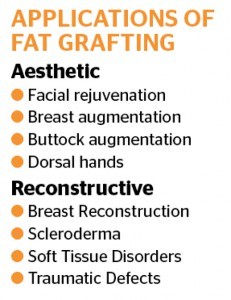Sasaki concurs. ‘For large volumes, the Puregraft method is very compatible to obtain large amounts of cells, which makes it ideal for breast and buttock augmentation, as well as using fat with implants for volume replacement when you are filling around the implant with the fat rather than using it as a primary method of filling,’ he said.
Zeidler divides her applications for Puregraft in breast surgery into four distinct patient groups. ‘The first group is post-lumpectomy patients who present with a dent in the breast that needs to be filled with fat. Next are patients who have had implants for breast reconstruction. During the surgery to switch out the expander for a permanent implant, I add more fat to touch up the final outcomes making a thick layer of tissue over the implants to make them look soft and natural. I may add 200 to 300 cc’s of fat on each side, under the nipple, in the cleavage area, and for fine tuning to dents left behind by the mastectomy.’
The third group of patients Zeidler identifies are women who choose to undergo autologous breast reconstruction. ‘I primarily do DIEP (deep inferior epigastric perforators)flaps for autologous reconstruction. They recover from the initial surgery and then come back for a second surgery where I use fat grafting to smooth out contours, particularly in the cleavage region, and to even out flaps.’ she added.
The final and fourth group of patients that benefit from fat grafting to the breast are cosmetic patients undergoing breast augmentation. ‘Fat can be used to even out small differences in breast size, to be added to the cleavage region for added fullness, or over implants to make them look more natural. Many patients are happy to use their fat for these issues rather than place different sized or shaped implants,’ comments Zeidler.
Cohen is also an avid proponent of using Puregraft in the breast. ‘It is like giving a surgeon clay to work with. When you look at the breast and surrounding chest wall, and you only have three shapes and a roster of sizes of implants to choose from, it is limiting in how that might match the patient’s body. But when you can add fat to address other regional anatomic variations, the surgeon has a powerful tool to do a better job both for augmentation and for patients who require reconstruction with fat.’
User-friendly fat grafting
Due to the simplicity of the Puregraft technology, it has proven to be very easy to adopt both for surgeons and the operating room (OR) staff.
Erica Fogelsong, R.N. works with reconstructive plastic surgeon Frank Elliott, MD, FACS at Northside Hospital in Atlanta, Georgia. ‘Dr Elliott prefers not to use wet fat because most of it will get absorbed, which is why we thought Puregraft would be ideal for his patients. We like the simplicity of Puregraft. It has definitely sped up the OR process and is more efficient than other methods we have used previously. It was very easy from the very first time. It takes only 5–10 minutes to harvest and lay out the fat with Puregraft,’ she said.
The Puregraft range of products feature sterile, single-use disposable units in three sizes (50 mL, 250 mL, and 850 mL), designed for optimized fat grafting to the face, body, and breast.




